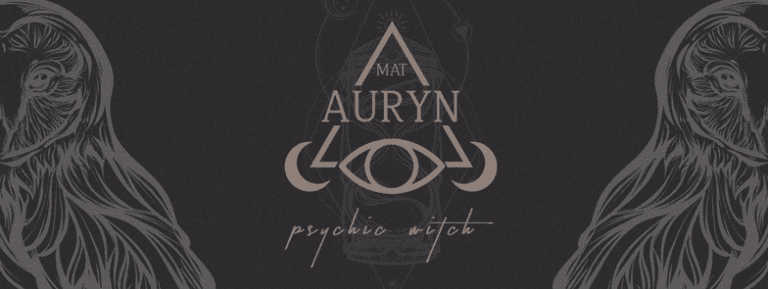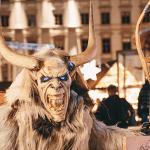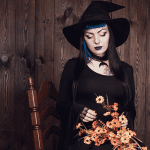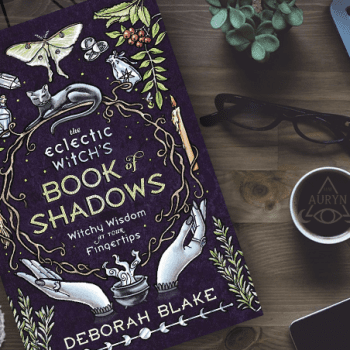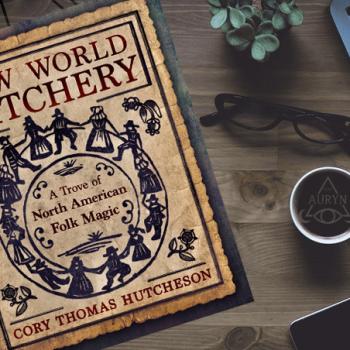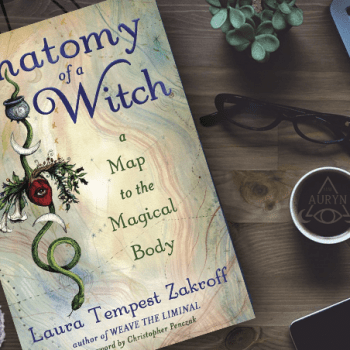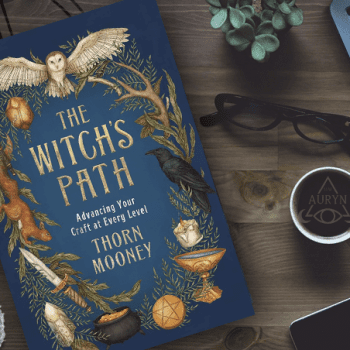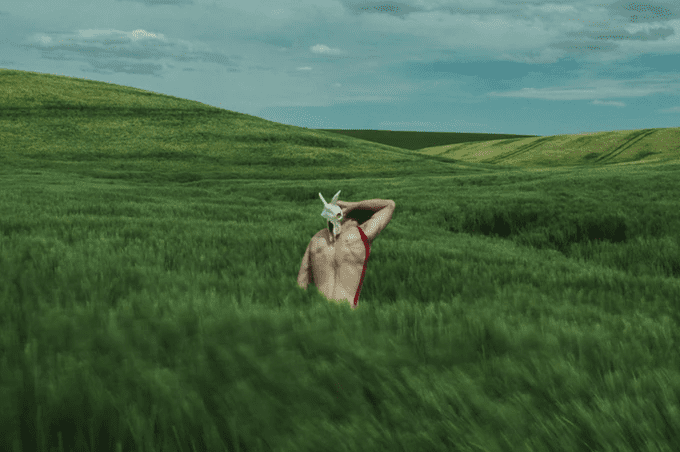
Chris Allaun has been studying paganism and the occult since 1992. He is an ordained minister with The Brotherhood of the Phoenix and has been an initiate of Traditional Witchcraft since 2002. He is also a Native American Pipe Carrier and studies that path of the Red Road. He teaches classes and workshops on magick, healing, shamanism, and necromancy. He has taught at pagan festivals such as Pagan Spirit Gathering and Between the Worlds. He continues to study and teach the magickal arts to those who seek to balance the three worlds in their own lives. He is the author of Underworld: Shamanism, Myth, Magick, and Deeper Into the Underworld: Death, Ancestors & Magical Rites For more information on Chris and his work, check out his facebook author page.
How did you get involved with magick?
My first experience with spirits is when I was two years old. In fact, it’s my earliest memory. I remember sitting by the front door in my living room and it had a little window to see out. All of a sudden a spirit who took the shape of a cartoon character appeared and waved at me. I screamed because at the time I didn’t understand what that was. I had a great aunt who lived in Arizona. Whenever she would visit us in Texas she would tell us about how she and her daughters had an Ouija board and that they and my mother would talk to the dead. She would tell us stories of ghosts, time loops, and hauntings. These stories resonated with me very much.
My mother would have prophetic dreams all the time. I would have prophetic dreams too as a kid. I was sensitive to spirits in our home throughout my whole childhood. We lived near the woods so my brothers and I would spend hours and hours in the woods. We used to call it Dead Man’s Alley because people would take their dead barn animals (horses, cows, dogs, cats, goats) and leave them back there to rot. I used to play with the bones. I know you are all shocked at this!
When I was 17 a friend found an article on Witchcraft in a women’s magazine. Reading about the magick of nature spoke to me on a deep level. As soon as I could I found Raymond Buckland’s “Complete Book of Witchcraft” at the bookstore in the mall. From there I would read books on Witchcraft and Ceremonial Magick every chance I got. In 2001, I received formal training from Matthew Ellenwood and became an ordained minister for the Fellowship of the Phoenix in 2002. That same year I was initiated into Traditional Witchcraft. From there I just kept going. I never really stop learning more magick.
Some folks believe that witchcraft is the continuation of European shamanism. How do you define and differentiate the words “witch” and “shaman”?
The Traditional Witchcraft that I was initiated into had many shamanic elements so I can see where they can blend into each other. Witches have always been on the outskirts of society. A few hundred years ago witches considered themselves Christian. They didn’t have any affiliation or any beliefs in pagan religion at all. If you read the book, Visions of Isobel Gowdie by Emma Wilby, you will see that many witches got their powers out of a desperate need for survival and to better their life situation. Witches connect with the unseen powers to better themselves and to obtain their desires.
In Wicca, there is no Devil, but in Traditional Witchcraft there is. But, he’s not the Christian evil doer, but rather a chthonic deity of nature, smithcraft, and magick. The Devil isn’t’ the only name he goes by. He’s also known as The Master, Old Hornie, Bucca, and The Horned One. Witchcraft challenges social and religious norms in order to expand and evolve in consciousness and spiritual gnosis.
The word shaman, even though it is a specific term for a group of spiritual people in Siberia, has become to mean an indigenous healer who works with the spirits of the dead, the celestials, and nature spirits for healing and the well-being of the community through spirit work. Shamans also have a relationship with many animal spirits for healing, divination, and magick. The shaman focuses on the community rather than individual needs. In many shamanic teachings, the student is warned that to embrace the shamanic path will require the personal sacrifice of time and sometimes personal needs and desires.
Shamanistic techniques are often ecstatic, meaning, that the healing techniques are taught by the spirits and require very few to no magical tools or props. The energies are summoned with dance, songs, and the powers of the spirits. Shamans practice their craft for the people with the guidance of the spirits.
I find it interesting that you’re heavily involved with witchcraft as well as a Native American Pipe Carrier. Since there’s a lot of talk about cultural appropriation within witchcraft of Native American practices, I want to ask your thoughts on that. What’s the boundary for cultural appropriation? Are there ways to respectfully incorporate practices of Native American spiritualities and religions into one’s witchcraft practice? Should only Native Americans work with certain plants such as salvia apiana (white sage)?
“Cultural Appropriation” is a buzzword right now. And it should be. Here in the US, the Native Americans have lost their land and many of their religious practices and ceremonies were banned and lost. Luckily, there are many ceremonies that are remembered and still practiced to this day. Being part Native myself, I take Native American spiritual practices very seriously. I’ve had many teachers for many years. So, in my practice, I do Native ceremonies. But I don’t blend them. I don’t do a Witchcraft ritual with the Chanupa (the sacred pipe).
Likewise, I don’t summon the Horned One into a sweat lodge. The practices were meant to do different things. There are some Native techniques that are actually commonly practiced in several different traditions. Things like drumming, smudging, plant medicine, and spirit work. So you can do those things in your witchcraft practice. It becomes appropriation when you take a Native taught ceremony and say, “Oh this is Heathenism or Wicca”. No, it’s not.
But simply drumming and coming up with your own magical song is not appropriation. Heathens used to smudge with mugwort to purify and give offerings of smoke to the spirits. When it comes to using plant spirits I think anyone can use them. Many plants grow wild in the US so we use them because they are a part of the land we live on. I know there is a hot topic of sage use by non Natives right now. What’s happening is that sage is being overused and many Natives feel it’s not being used in a sacred manner and not being replenished fast enough because of the overuse in the New Age movement. It’s better to grow our own plant medicine but in certain environments, it doesn’t grow as well. For me, I think if we work with the plant spirit in a sacred way and use them for healing then it’s ok. We do need to be careful of overuse.
I have noticed that a very large portion of men involved with witchcraft tends to be queer. As a queer witch, why do you think this is?
Witches are known for pushing social and religious norms and queer people are very accustomed to doing this. We are used to being thought of as strange and weird. The word “queer” itself means weird and strange. Witchcraft is a craft. A craft of power. There are many queer people who have felt disempowered and outcasts their whole lives. Witchcraft embraces these strange and wonderfully weird qualities. Many queer people have kindled the flames of inner power and strength because of witchcraft.
One of the reasons I resonated with magick and witchcraft is because it is excepting of queer folk unlike Christianity and many other patriarchal religions. A lot of us grew up in a Christian society that told us we were wrong and even going to hell and be punished for our sexual desires and who we love. Then we discover a spiritual practice that says we can be queer and embrace sex. Sex is seen in witchcraft as a sacred act and should be embraced. For many of us, embracing witchcraft was a healing experience away from the tyrannical philosophies of Christianity. Witchcraft is about accepting yourself no matter what and if you destroy some social norms, then all the better.
Do you think queer folks have a different relationship to magick and the mysteries than cis-het folks? Why or why not?
I’ve never been straight so I can’t speak to their experience but I can guess that if queer people do connect to the energies and mysteries differently it’s because we often embrace both our masculine and feminine natures. I once heard that only men should invoke male deities and only women should invoke female deities because they resonate with those energies. For queer people, we often resonate with both energies (but not always). So, it may be easier to connect to the energies of both gods and goddesses.
Likewise, in Solomonic Magick some people teach that men are better magicians (active force) and women are better seers (receptive energies). I always thought that this was silly. I trained myself to do both quite well. Maybe its because I’m gay. But I think it’s because I practiced and practiced often. In Taoism, all humans have a male energy (Li) and a female energy (Kan). It is the goal of the mystic Taoist to balance those two energies that you may find balance and healing. I think many straight men have a hard time embracing their receptive nature because they think it makes them less masculine or weak in some way. I think that if we can all work on our energy blocks and fears that we will all become more power magicians, witches, and shamans.
You wrote two books on the subject of the Underworld; Underworld: Shamanism, Myth, Magick, and Deeper Into the Underworld: Death, Ancestors & Magical Rites. What do you think are the biggest misconceptions of the Underworld?
I have found that the biggest misconception of the Underworld that it is only a primal place of the ancestors and totem animals. This is defiantly part of the Underworld but the worlds below are far more than this. At the beginning of someone’s journeys, they will find this world of ancient forests long gone, but this is only the start of the adventure. As you go deeper into the Underworld you will find many different worlds. There are the hellworlds, the worlds of the ancestors, the worlds of chthonic entities, and lost spirits. In Greco-Roman mythology, Tartarus was a hellworld that imprisoned the Titans.
In Kabbalistic Magick there is the Qlipoth. Qlipoth means “shell” and is the cast-offs of when the Sephira of the Tree of Life were created. The Qlipoth is the inverse of the Tree of Life and is the home of demons and monsters. It is also the home of the Lilith, the mother of Vampires. The Underworld also has much wisdom and healing. In Nordic Mythology, we have the well of Mimir. Mimir is the wise god of the Aesir who gave prophesy and wisdom. His head was cut off by the Vanir gods. Odin used his magick to resurrect the head of Mimir and placed it in the Underworld well. As I have said in my books, the dark worlds below help us face our shadow and our fears. By facing our fears we will open up energetic blocks in our mind that allows us access to power psychic abilities and wisdom.
Why would the ancestors help queer folks and those who don’t want to reproduce and have children if they’re trying to continue their legacy? What is the relationship between queer people or those who don’t want or can’t have children and their ancestors?
I think it’s a misconception that ancestors don’t want to help their descendants who don’t want to have children. It is true that if your grandmother died and she really wanted you to have children then she will also want that in death. However, the dead have spiritual teachers in the Underworld who help them spiritually evolve. The ancestors will learn to see past many of their earthly desires to see the bigger spiritual picture. Granted, their personality will be the same and they will have the same strengths and weaknesses as they did when they were alive, but they do evolve.
The Christian world doesn’t really honor the dead. I have found when someone creates an ancestral altar and gives daily prayers and offerings, the ancestors are very happy that their descendant is remembering them and giving them energy. They may ask about children at first, but once they see the healing and magical work we are doing they will start to see the bigger picture. Remember, unless you are a part of a pagan family, you may be the only family member who is honoring the beloved dead. You are the only connection that the ancestors have to their living family. Yes, they can watch and influence them, but they have a direct relationship with you. They will be grateful for the opportunity to speak with you and may even eventually work with you in magick.
What do you feel the biggest misconception about ancestors and ancestral work are?
I have found the biggest misconception about working with the ancestors is that it is a dark and shadowy practice. That with ancestor work comes dark spirits and shadows that seek to destroy us. This comes from Christian teachings that say any spirit that is not an angel must be demonic. Working with the ancestors is not dark at all. It’s a very healing practice. One of the things it does it establishes a relationship between you and the dead. This relationship can heal family karmas that have been passed on from generation to generation.
The ancestors can see the energy worlds very clearly. They have the ability to see the past, present, and future. When we seek the council of the ancestors they can share the events that are soon to come and give clarification of events from the past. Also, if trickster spirits do come to the ancestor altar, the ancestors have the magical ability to protect their space and your home from any spiritual intrusion. They can also do this with living intruders as well. Working with the ancestors and honoring them is a healing practice that helps with the spiritual evolution of them as well as yourself.
With both shamanic practices and witchcraft practices, I find a lot of folks question their experiences as just being their imagination. How important is imagination and what role does it play in these experiences?
Is it real or is it my imagination? Well, it’s both. The imagination is the fuel that magick uses to manifest. In the beginning, when we are learning to strengthen our psychic skills, we are often told to visualize. Visualize the pentagram. Visualize the goddess standing before you. What is visualization but our imagination? Remember, that energy is abstract. When we view the astral or energy worlds without imagination it looks like colors, vibrating lines, sparkly light, and sometimes just bright light.
Our imagination gives the energies of the spirits a form to help them manifest in the astral and physical planes. Our brain likes symbols and pictures. Most of us are visual thinkers. So, in order for the spirits to communicate in a way we understand they need to manifest in a way we understand. They do this by our imagination. This is one of the reasons why Greek Gods look like the Greeks and Celtic Gods look like the Celts. The gods communicate to us in a way we understand.
Your next book is on the Upperworld – can you share a bit about the book? What can we look forward to?
I’m very excited about the release of Upperworld: Magick and Shamanism of the Celestial Realm. I found that there are not many books that deal exclusively with Upperworld energies. Yes, there are books on gods and astrology, but this book is different in that I teach you how to journey to the above worlds so that you may have a personal relationship with the gods, angels, and other entities. In the book, I teach you how to journey into the Upperworld and explore the worlds above. I also teach you about the spirits of the planets and how to use them in magick.
The Chapter on Stars teaches how to use star constellations as portals into other planes and dimensions. Another chapter is on the Gods. The book teaches about the different types of relationships you may have with the gods and how to invoke the gods into your body. Also, you might find it strange, but I have a chapter on Angelic Magick as it pertains to shamans and witches. I go into detail about the Arch Angels, Melek Taus, and the powers of Lucifer that are beneficial to the witch.
The last chapter is on Universal Energies. Very often, as we progress upon our magical paths, there are many energies at play that we don’t understand. I de-mystify the energies of Karma, Dharma, Divine Will, The Dark Night of the Soul, and other energies that cause us to question our magical progress. Needless to say, this is a book I wish I had when I first was exploring the Upperworld.
Related Articles:
Review: Deeper Into The Underworld

